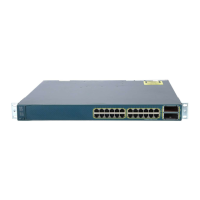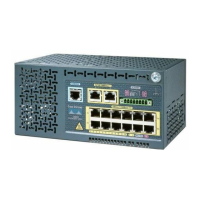34-68
Catalyst 3750 Switch Software Configuration Guide
78-16180-02
Chapter 34 Configuring IP Unicast Routing
Configuring Protocol-Independent Features
If you have not defined a default redistribution metric that replaces metric conversion, some automatic
metric translations occur between routing protocols:
• RIP can automatically redistribute static routes. It assigns static routes a metric of 1 (directly
connected).
• IGRP can automatically redistribute static routes and information from other IGRP-routed
autonomous systems. IGRP assigns static routes a metric that identifies them as directly connected.
It does not change the metrics of routes derived from IGRP updates from other autonomous systems.
• Any protocol can redistribute other routing protocols if a default mode is in effect.
Configuring Policy-Based Routing
You can use policy-based routing (PBR) to configure a defined policy for traffic flows. By using PBR,
you can have more control over routing by reducing the reliance on routes derived from routing
protocols. PBR can specify and implement routing policies that allow or deny paths based on:
• Identity of a particular end system
• Application
• Protocol
You can use PBR to provide equal-access and source-sensitive routing, routing based on interactive
versus batch traffic, or routing based on dedicated links. For example, you could transfer stock records
to a corporate office on a high-bandwidth, high-cost link for a short time while transmitting routine
application data such as e-mail over a low-bandwidth, low-cost link.
With PBR, you classify traffic using access control lists (ACLs) and then make traffic go through a
different path. PBR is applied to incoming packets. All packets received on an interface with PBR
enabled are passed through route maps. Based on the criteria defined in the route maps, packets are
forwarded (routed) to the appropriate next hop.
• If packets do not match any route map statements, all set clauses are applied.
• If a statement is marked as deny, packets meeting the match criteria are sent through normal
forwarding channels, and destination-based routing is performed.
• If a statement is marked as permit and the packets do not match any route-map statements, the
packets are sent through the normal forwarding channels, and destination-based routing is
performed.
For more information about configuring route maps, see the “Using Route Maps to Redistribute Routing
Information” section on page 34-64.
You can use standard IP ACLs to specify match criteria for a source address or extended IP ACLs to
specify match criteria based on an application, a protocol type, or an end station. The process proceeds
through the route map until a match is found. If no match is found, or if the route map is a deny, normal
destination-based routing occurs. There is an implicit deny at the end of the list of match statements.
If match clauses are satisfied, you can use a set clause to specify the IP addresses identifying the next
hop router in the path.
For details about PBR commands and keywords, refer to the Cisco IOS IP Command Reference, Volume
2 of 3: Routing Protocols, Release 12.2. For a list of PBR commands that are visible but not supported
by the switch, see Appendix C, “Unsupported Commands in Cisco IOS Release 12.2(20)SE.”
PBR configuration is applied to the whole stack, and all switches use the stack master configuration.
